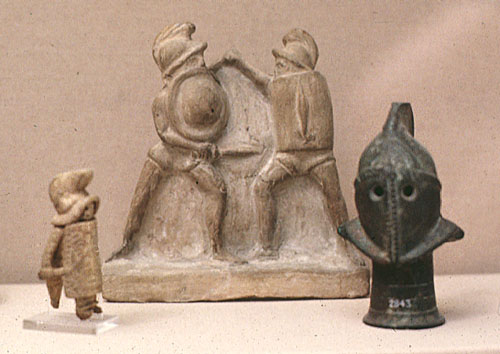
In the afternoon came the high point of the games--individual gladiatorial combats. These were usually matches between gladiators with different types of armor and fighting styles (more information about the different types of gladiators). Although it is popularly believed that these bouts began with the gladiators saying "Those who are about to die salute you," the only evidence for this phrase is found in the description of a naumachia staged by Claudius using condemned criminals, where the men supposedly said Ave, imperator; morituri te salutant (Suetonius, Claudius 21.6). This was certainly not a typical gladiatorial combat and cannot be used as evidence for typical practice.
There were, however, many rituals in the arena. When a gladiator had been wounded and wished to concede defeat, he would hold up an index finger, as clearly depicted on the Colchester vase and on this mosaic. At this point the crowd would indicate with gestures whether they wished the defeated gladiator to be killed or spared. The popular belief (illustrated in "Pollice Verso," an 1872 painting by Jean-Leon Gerome; see this detail) is that thumbs down meant kill and thumbs up meant spare, but we have no visual evidence for this, and the written evidence states that pollicem vertere (to turn the thumb) meant kill and pollicem premere (to press the thumb) meant spare. This may, in fact, indicate that those who wanted the gladiator killed waved their thumbs in any direction, and those who wanted him spared pressed their thumbs tightly against their hands, as shown in this relief (closer view of hand). In any case, the sponsor of the games decided whether or not to give the defeated gladiator a reprieve (missio). If the gladiator was to be killed, he was expected to accept the final blow in a ritualized fashion, without crying out or flinching. Some scholars believe there was also a ritual for removing the bodies of dead gladiators, with a man dressed as Charon (ferryman of Hades) testing the body to make sure he was really dead and then a slave dragging the body with a hook through a gate called the Porta Libitinensis (Libitina was a death goddess), as depicted in this modern drawing.